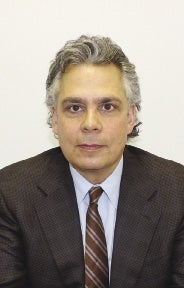Harrington meets demand for behavior, substance treatment
 Greg Mirhej, director of behavioral services, Harrington HealthCare System
Greg Mirhej, director of behavioral services, Harrington HealthCare System
When Greg Mirhej first joined Harrington HealthCare System about four years ago, the signs that opioid addiction was going to become a nationwide epidemic were just starting to show. Now, demand for the drug is at an all-time high, and people of all ages are susceptible to its devastating effects.
The disease affects everyone from older adults to children, including one 12-year-old girl that Mirhej worked with. The girl, who showed up to her appointment with a Hello Kitty lunchbox, was doing four bags of heroin a day.
“I said, 'What is the place you're most at risk?' and she said, 'As soon as I open the door in my school.' She said, 'There are people I know, and they know me; and I'm going to get hit four times before lunch. It makes it hard to turn away,'” Mirhej said. “I never had that problem in school – wondering if I was going to make it to lunch without someone asking me if I want to do heroin.”
Heroin's grip on the lives of so many people has caused many healthcare providers to ramp up their services by adding employees and programs specifically geared towards addressing substance abuse disorders. Harrington HealthCare has worked to establish itself as that presence in southern Worcester County, adding more than 300 employees in the last year.
With the help of a state grant for community hospitals, Harrington has expanded behavioral health to include better access to care and patient follow-up – two critical pieces of the recovery puzzle for substance abuse disorder. It has also been a critical part of the success of treatment-based drug courts for young adults arrested on substance abuse charges.
Crisis response
The opioid crisis was just starting to rear its ugly head when Mirhej joined Harrington. A crisis of that magnitude can only be dealt with if a healthcare provider takes an active role in addressing it, he said.
“You have to be in the courts, which we are now. I think you have to be in the hospitals, in the personal care offices. You have to have services that are very accessible,” said Mirhej, who is now director of behavioral services at Harrington.
One of the ways the nonprofit did this was by becoming the healthcare provider for the Dudley drug court. Through the court, people arrested on substance abuse charges get access to a hyper-personalized, treatment-based court. It's a different approach to substance abuse, maybe a complete 180-degree turn from the War on Drugs of days past.
“Unlike most courts where you come in and it's like, 'You were positive again … We're going to lock you up for another month,' this is like, 'Ok, what do you need? What's not working? What's happening?'” Mirhej said.
It's not without consequence, but it's a better alternative to locking people up when they fail a drug test, he said.
East Brookfield and Uxbridge now have their own drug courts, and Harrington hopes to help create a county-wide network of courts, Mirhej said.
Integration of services
Through the $3.5-million grant Harrington received, called the Community Hospital Acceleration, Revitalization, and Transformation (CHART) Investment Program, the nonprofit has put more resources towards closing the gap between behavioral health and what might be seen as more conventional medical services. Historically, these two branches of treatment have been approached as two separate issues rather than together, to the detriment of some patients, Mirhej said.
“It's almost as if we split the brain and the body. The people in the hospital treat the body like we treat the brain,” he said. “It's very divorced.”
Yet, medical problems and behavioral health problems co-occur all the time. Closing the gap between these health services is a big focus of healthcare reform, said Anuj Goel, vice president of legal and regulatory affairs for the Massachusetts Hospital Association.
“In terms of healthcare reform, they talk about integrating care organization, where we develop these integrated models of care to try to help address the patient's needs,” Goel said.
Through the CHART grant, Harrington has been able to put behavioral health practitioners in its Charlton and Webster primary care offices and in its emergency room in Southbridge. In the past, if a primary care physician thought a patient might have a substance abuse disorder, he or she would get a referral to a behavioral health provider. The problem is, most patients who received a referral never showed up, Mirhej said. Having a behavioral health clinician on staff means the patients can get the help they need right then and there – hopefully reducing the chance that they'll get lost in the shuffle.
The CHART grant has also allowed Harrington to add navigators, who get to know patients personally, do home visits and drive them to appointments if need be. The hope is that adding navigators and behavioral health clinicians in PCP offices and the ER will reduce re-admittance rates by 15 percent.
One of the reasons people stop their substance abuse treatment and go back to using opioids is access to care, or just lack of care. This can be especially challenging in rural southern Worcester County, where transportation is an issue.
“Out here, you have people who are just super isolated,” Mirhej said. “There are no buses. A lot of people don't have transportation anywhere. Just setting up shop somewhere and saying, 'Everybody come,' doesn't work.” Navigators will help solve that problem, he said.
A local network
Mirhej's ultimate goal is to create a vast network of easily-accessible behavioral health treatment centers throughout southern Worcester County. He also wants to increase access to behavioral health services in schools, add more staff psychiatrists, and look into the possibility of administering suboxone in emergency rooms.
Later on this year, a new inpatient treatment center for patients suffering from both behavioral health and substance abuse disorders will open at Harrington's Webster campus on the site of the former Hubbard Regional Hospital.
The center will have 16 inpatient beds as well as a partial hospital treatment center for dual-diagnosis patients who are either transitioning out of inpatient care or need a structured program with a doctor present.
“Once that's done, we'll be able to serve children and families, adults with mental health issues, substance abuse, outpatient, intensive outpatient, partial hospital and inpatient programs, as well as medication-assisted treatment,” like suboxone, which have been instrumental to opioid treatment, Mirhej said.
Harrington offers suboxone and vivitrol as medication-assisted treatments in Southbridge and Dudley and hopes to expand those services to Webster.
“There aren't psychiatric facilities or units that have the capacity or capability to treat [dual diagnosis] patients,” Goel said. “We need more units like what Harrington is developing.” n













0 Comments